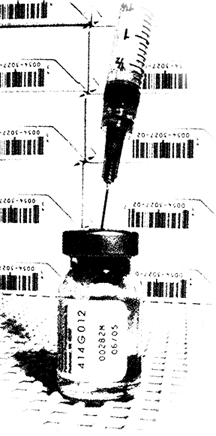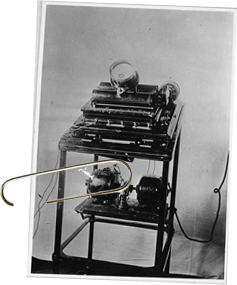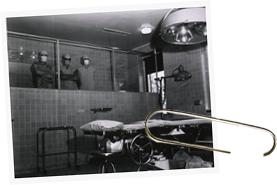

|
CHART #
009201***** |
PRIMARY FACILITY
Vestibriüm University Hospital |
CODE
|
ATTENDING PHYSICIAN
(Kördann) |
TYPE
? |
AU
|
|
DISPOSITION (STATUS)
In progress |
ARTICLE (JOURNAL REF)
Module (With Bonus Materials for Review and Discussion) |
||||


Dr. Kördann took position at the head of the operating table. "Today's patient," she told the select assembly of medical students, "is a thirty-one year old man with some bizarre condition. We've been unable to nail down the exact pathology, but we've elected to perform a heart-lung transplant. As you can see, most of the groundwork is complete, and we're nearly ready to pull the old tissue. In itself, a rather trivial procedure -- the extractions, I mean."

So, as surgeons emptied the thorax, a nostalgic Dr. Kördann took the opportunity to reflect on the Eisinbrüge Maneuver, which she had pioneered some years earlier. "I remember my first heart-lung," she said. "Removed the diseased organs without too much difficulty... They were toast by the time we got in there. But when I saw the donors, I knew we had trouble. Looked like they had been ripped out. I mean, I had planned on re-sectioning anyway, but these weren't even clamped correctly. Moot point, because the real killer was the medium. Totally saturated with Salinenadyne crystals, leaving the tissue dehydrated and toxic. Necrostrocized. Couldn't even think about using them. Turned out they weren't even fresh -- probably in that cooler for weeks. Well, I guess that's a risk when you use secondary markets. Obviously, I couldn't put the old organs back. I mean, they had come out in pieces, so there's no way they would even hold a suture. Can you imagine? I mean, trying to bring the vasculature up to pressure? Basically, we would have poured our entire blood supply down the drain. So, there we were. And to make matters worse, the machine was needed in another room, so the clock was ticking. Legally, I suppose I was obligated to plod onward, but I wasn't about to waste my time installing dead parts. So I was ready to just pull the plug and call it when the supervising doc keeled over. Aneurysm. We did what we could, but none of us were very skilled in that type of thing, so he died on the spot. Without thinking, I pulled his organs and dumped them in the original patient. Fortunately, the tissue was a match, so everyone was happy. But still... That one could have been bad."

And, with that, she returned her attention to the current patient. "So here we are," she noted. "Organs removed. What next?" The ensuing silence prompted one of the medical students to cite the obvious: "Where are the donors?" Dr. Kördann nodded thoughtfully. "That would seem a reasonable question," she agreed. "Where are the donors? Or, more specifically, who is the donor?" She looked around the room, visually assessing each of the med students. Finally, she decided on one. "You," she said, "Approach the table." With obvious hesitation, the surgical apprentice obeyed and stood alongside the gutted torso. "This is your patient," Dr. Kördann decreed. "He has no heart. No lungs. What are you going to do?" The student shook his head, "Are you saying there are no donors ready?" Dr. Kördann repeated, "No heart and no lungs." The resident knit his brow and recited, "The machine will sustain... Uh, vital functions until..." But Dr. Kördann shook her head, "This is not an academic exercise. We have no more than four hours of blood in supply, and we're not getting more." The resident pressed his eyes shut, "Right. Well, then... There's no alternative but to replace the original organs and wait until..." But Dr. Kördann interrupted, "They're in the incinerator by now. No going back." And he viewed the assembly in desperation, sweat forming on his upper lip beneath the mask. "Your anecdote," he said. "The Eisinbrüge Maneuver. Is someone in this room expected to... Pass?"
At that, Dr. Kördann laughed. "Divine intervention is frequently indicated, but I'm at a loss for methods to induce it. At least, with reliable outcome."
So the confused student shrugged, "Then there's nothing. Unless... Prosthetics?" he offered weakly. Dr. Kördann raised an eyebrow. "Prosthetic lungs?" she mused. "I assume you're referring to some type of Käuffmon tissue construct." The resident nodded vigorously, "Yes, yes... That's it. Biosynthetic molecular plasma-based polymers... Gaseous exchange efficiency of nearly seventy-five percent under optimal conditions." Dr. Kördann nodded. "I'm impressed," she admitted. "I wasn't aware that my colloquiums ever left the theater. But, unfortunately for you -- and your patient -- Käuffmon tissue is years away from human testing. Of course, if you had access to the material, you might risk it... In the interest of science or the greater good of humanity. Or perhaps just to prolong this man's life, if only for a few days. Of course, you would forfeit your own life in the process. Your career, at least. Not to mention the likely manslaughter charge and civil suits..."
The resident's mask expanded as he sighed. "I never wanted to lose a patient," he said. "I've had perfect exam scores, good lab technique. I thought that if I was careful..." Dr. Kördann nodded again. "I know," she asserted, "That's why I picked you."

She turned to an adjacent table and removed the uppermost blue cloth to reveal a stainless steel tub filled with ice water. She plunged her gloved hands into the liquid and retrieved two small bulbs of shiny white polymer. "State of the art synthetic respiratory tissue," she announced. "But untested. And obviously unapproved. If you choose to risk it, a Veltronik pump is in inventory, and I have Käuffmon's complete specifications for set up, which I might have already practiced myself." Beads of sweat now on the residents forehead... "Are you advising that I...?" Dr. Kördann shook her head decisively, "No. Ethical dilemmas cannot be decided by committee. This decision is yours alone. I'm merely a facilitator. If you wish, I'll clear the room... Except for vital staff, of course." The resident pressed his eyes shut. "If I don't attempt these prosthetics, he dies, right?" Dr. Kördann glanced at the near-carcass. "That's my professional assessment," she concurred. The resident placed a gloved hand on the patient's shoulder. "Then this man... Dies," he pronounced. "It's my responsibility to provide him that dignity."
Dr. Kördann tossed the lungs in a trash bag and turned to one of the other attending physicians. "Pull the liver. They need it downstairs." Then she placed her hand on the resident's arm. "Maybe this was academic," she admitted. "An illustration of the most vital lesson in medicine, while raising a Specter with whom you'll become most familiar in the coming years. An effective tool. At least it was for me."
The resident untied his mask and glared with disdain. "Did I pass?"
Dr. Kördann shook her head. "That's not for me to say. These exams are self-graded. It's up to you if you even want to put a mark on it. But given a choice between forgetting all that I've learned, or remembering that which I've never known... I wouldn't be so anxious to seal my fate."